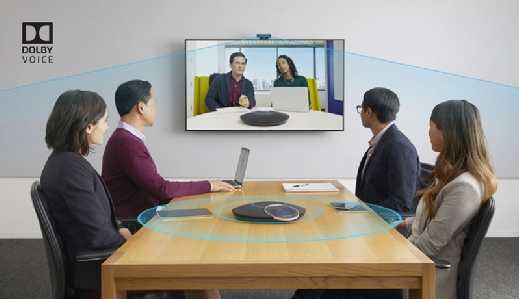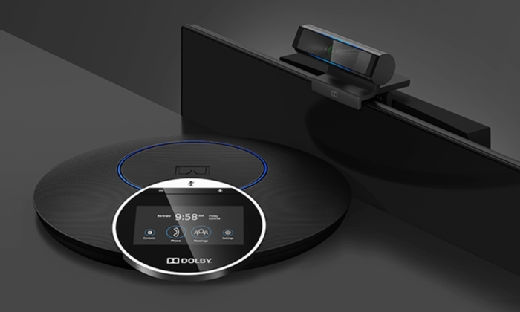Dolby Voice Room conferencing product wins Network Innovation Award
Dolby's new video conferencing product, Dolby Voice Room, targets the huddle room market, while touting high-end audio capabilities and ease of management.
Dolby Laboratories Inc. has won this month's Network Innovation Award for its Dolby Voice Room, a video conferencing product geared toward small meeting rooms. The audio-visual devices combine three components: Dolby Conference Phone, Dolby Voice Camera and Dolby Voice Hub.
The conference phone, which is the centerpiece of the product, also serves as the control center for video conferencing. Dolby's audio technology can adjust the acoustics of the meeting room by boosting the volume of distant or quiet voices and blocking background noise.
The 4K wide-angle camera and high dynamic range video mapping adjust to lighting and motion within the room, as the camera automatically frames meeting-room participants. In addition, without moving, the camera can frame a whiteboard, so remote participants can see the board better. For example, if a whiteboard is on a side wall of the room, the camera uses signal processing to focus on the board and present the complete whiteboard image to remote users.
Currently in beta, Dolby Voice Room is expected to be available by late May or early June to customers of BlueJeans and Highfive, two video conferencing providers. The planned MSRP for Dolby Voice Room is $4,500 to $4,700.
In an interview, Andrew Border, vice president of Dolby's communications business group, discussed Dolby Voice Room, among other topics. This interview has been edited for length and clarity.
How is the Dolby Voice Room video conferencing product innovative?
Andrew Border: We focused on how audio works in real life and how that can be applied to meetings. We can do spatial audio for conference rooms, so we can separate talkers and make it easier for people to understand. We also have noise-reduction capabilities, because a lot of meetings happen in busy environments on mobile devices, and that's often a problem on conference calls.
As we started working with BlueJeans and Highfive, we realized there was potential to make the experience more natural from a visual communications point of view, as well. Dolby Voice Room adds that visual element with a Dolby-designed camera that has a lot of flexibility in terms of features and functionalities.
We believe there's a lot of interest in customers having powerful, flexible room systems. But they want it in a way that's manageable and easy to deploy instead of running Windows 10 software in the meeting room or with the display having a separate iPad. The idea is having the flexibility and power of a modern environment, and having it manageable and secure for the IT team, as well.

Where does Dolby Voice Room differ from other huddle room kits?
Border: The conference phone can deal with a huddle room, but it can also cover a 20-seat boardroom. The audio capability, we believe, is second to none.
The huddle room market is divided between traditional systems, like Polycom and Cisco, and build-it-yourself systems with a third-party camera, USB speakerphone and some software. [A build-it-yourself system] is cost-effective, but operating and managing it can be challenging for some enterprises.
We're trying to bridge the gap between the features and functionality of the high-end, traditional systems and the price point and flexibility of the build-it-yourself huddle room solutions.
The other part we're looking to differentiate around is the video experience. We built a machine learning algorithm that can intelligently frame the meeting. It dynamically reframes the scene to capture where I am, no matter where the camera is.
How is Dolby Voice Room deployed on the network?
Border: The conference phone is a standard PoE [Power over Ethernet] device, so it lives on the network. It can connect to the customer's VLAN [virtual LAN] securely. It's designed as an enterprise-grade network device that can support third-party PBXs. We feel that's important, because it gets rid of another device in the room.
When we researched these products, we found people would have the build-it-yourself huddle room kit, with no network management, lots of cables and a traditional speakerphone sitting right next to it, as well.
[Dolby Voice Room] has been designed as something that fits into an enterprise security profile from a telephony point of view, from a deployment point of view, with a UI the user can understand.
Talk about your approach to endpoint management.
Border: We have a solution called Dolby Conferencing Console, which is a management tool where the enterprise has complete visibility into the Dolby Conference Phone and Dolby Voice Room solution.
So, say you want to roll out 100 huddle rooms for the Dolby Voice Room solution; you can preprovision all those devices. When they connect to the network, you have full visibility of them. If you want to push a firmware upgrade to all the devices in a certain office at 2 a.m., you can schedule that and get a report. And you can see the traffic management -- every call and network conditions, including information around the audio and video experience to help with network troubleshooting issues.
So, that's another big difference compared to some other huddle room solutions out there.

Background noise can be an issue. What capabilities are engineered into Dolby Voice Room to address that?
Border: It's fairly sophisticated. There's a machine learning algorithm that adapts and learns what's human speech versus background noise. Often, on a call, you might hear a little background noise. But, as the algorithm works out what's speech and what's not, you'll hear that background noise vanish.
Also, Dolby Voice is fairly ingenious in that we don't send packets from soft clients when people aren't talking -- so that also reduces noise on the line. But, from the audio point of view, Dolby Voice Room is probably most impressive with its pickup range and hearing a clear back and forth in the room.
What benefits will users get from Dolby's auto-framing?
Border: With our intelligent scene frame, we're doing a small single-element camera that doesn't move. Solutions that have pan-tilt-zoom cameras -- where they're moving in the meeting -- are generally quite large. Users find them distracting, because they're a little noisy and intimidating. We wanted something more subtle that you forgot was there.
Because other systems work on active-talker tracking, they tend to have tight-cropped framing shots. In a huddle room, I'm more interested in seeing all the people framed as effectively as possible. Our system pulls back, so you can see more of the room. We wanted to make the technology less intrusive.
If you do a tight crop on the active talker, you're missing the other reactions in the room, which sometimes are more interesting than what was said.







